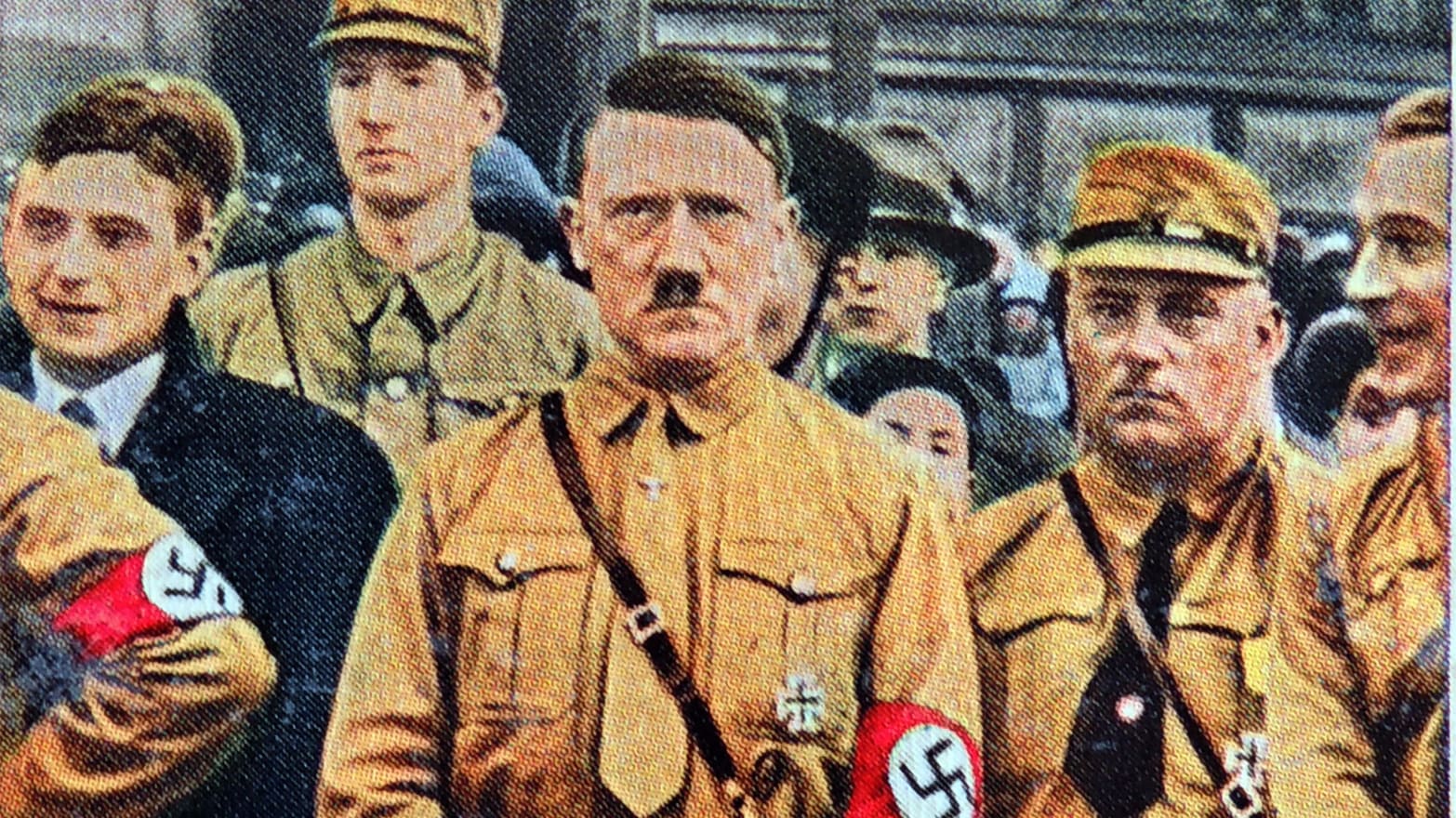Adolf Hitler’s obsessions, for he was a man prone to unhealthy fixations, were dangerous for the world—whether with himself, with art school, with his dreams of grandeur, with Eva Braun, with his hatred of Jews—or, more obscurely, with Turkey.
To say that the roots of the Third Reich’s rise have been thoroughly examined would be an understatement. Yet one element of Hitler’s power grab has largely been neglected—the importance of Turkey and Mustafa Kemal Atatürk (or as Hitler called him, his “shining star”) on the Führer’s thinking.
In his exhaustively researched new book, Atatürk in the Nazi Imagination, Stefan Ihrig charts the outsized role that Atatürk and the New Turkey played in the minds of Germany’s Weimar-era far right—an influence that extended through the Nazi years. The Turkish Revolution was the most hotly-debated foreign issue in the early 1920’s, and not only did the Nazis model themselves after the Turkish National Movement, but Nazi leaders from Hitler and Goebbels were personally entranced by everything Atatürk did.
In the aftermath of World War I, Germans—conservatives in particular—became consumed with the idea that they had been unfairly treated at the Paris Peace Conference (‘raped’ is a word they often used), and stabbed in the back by supine bureaucrats and minorities in Berlin. Yet even as the Germans wallowed in bitter self-pity, another defeated superpower underwent a dramatic turnaround.
When the last vestiges of the Ottoman Empire were dismantled by the Allies in the Treaty of Sèvres, modern-day Turkey was also chopped up, with large portions going to Greece and Armenia, as well as major powers like Britain, Italy, and France. However, beginning in 1919, Turkish nationalists—led by Atatürk in Ankara—transformed from beleaguered underdogs into a determined force that beat back the Greeks, French, and Armenians on multiple fronts. Over a tough few years, they defeated the seemingly invincible forces arrayed against them—and, more importantly, they were able to negotiate a new treaty, the Treaty of Lausanne, in 1923, which established modern Turkey.
“In the eyes of a desperate and desolate Germany,” writes Ihrig, “this was a nationalist dream come true, or rather something like hyper-national pornography.”
On June 29, 1919, German newspapers announced the previous day’s signing of the Treaty of Versailles, which ended World War I and forced Germany to pay reparations and concede territory. Just two days later, the papers began what can only be described as a love affair with Mustafa Kemal Pasha (later Atatürk). Coverage of Turkey and its swashbuckling leader would fill Germany’s daily and weekly newspapers.
Over the next four and a half years, the conservative paper Kreuzzeitung would run a total of 2,200 articles, items, and reports on Turkey. The Nazi-affiliated Heimatland gave one-eighth of its space each week, from September 1 to October 15, 1923, to features on Atatürk. Papers throughout the country would refer to Turkey as Germany’s “role model.” Nationalist opinion-makers would laud what they saw as Turkey’s strong negotiating tactics—essentially ‘give us all that we want or we will continue to fight’—and decried German acquiescence to Allied terms. Some, like the influential pastor and politician Max Maurenbrecher, even began to argue that if Germans had fought for their freedom and borders like the Turks, they would not be suffering the onerous conditions of Versailles. Turkey’s revolution was a “revisionist-nationalist dream come true, even a fetishized version of it, because it had been achieved by the sword, in the field, with major battles, and many epic twists,” writes Ihrig.
In fact, Ihrig says, Turkey was to become a sort of Fürstenspiegel for conservative Germans. A Fürstenspiegel, or “mirror for princes,” is a genre of literature that uses a distant story (either geographically or historically) to advocate for certain actions in the present. German conservatives writing about Turkey would praise its active militant role in forging its national destiny, and laud the ways in which Atatürk had come from Ankara, not Constantinople, to lead a unified völkisch movement. That Atatürk was from Ankara was important, because Hitler and his allies saw their movement as having strength due its roots in Munich, not Berlin. Later, Atatürk’s life story would be used to promote the importance of a Führer.
The popular understanding of Hitler’s rise to power often points to the influence of Mussolini and his march on Rome. In fact, argues Ihrig, “the assumed role-model function of Mussolini, mainly deduced from the later significance of Fascist Italy, has led many authors to overestimate Italy” and as a result “few historians mention Atatürk as part of the general pre-putsch atmosphere.” In fact, as Ihrig points out, Mussolini called himself “the Mustafa Kemal of a Milanese Ankara” as he began his own power-grab.
Ihrig argues that the two main Nazi papers, the Heimatland and Völkischer Beobachter, were promoters of the “Turkish methods” as early as 1921. The Nazis argued that brute force had been necessary for Turkey’s independence, and, insidiously, they highlighted Atatürk’s crackdown on ethnic minorities and all of those who dissented. One Nazi ideologue, Hans Trobst, wrote explicitly about Turkey’s “national purification” of “bloodsuckers” and “parasites” like Armenians and Greeks; Trobst was later invited to meet with Hitler after the leader read his writings on Turkey. Ihrig notes that Hitler’s secretary wrote to Trobst in Hitler’s name, declaring, “What you have witnessed in Turkey is what we will have to do in the future as well in order to liberate ourselves.”
This praising of Turkish aggression was laying the groundwork for Hitler’s Beerhall Putsch, in which he attempted, and failed, to seize power in Munich in 1923. It was only after it failed, Ihrig contends, that Hitler saw it as necessary to go a more “legitimate” political route like Mussolini. In his final speech at his trial, Hitler would also point to Atatürk (and then Mussolini) as examples of why his attempt at seizing power was not treasonous—it was, he said, for “the gaining of liberty for his nation.”
A decade on, in 1933, Hitler would tell the Turkish daily Milliyet that Atatürk was, in his words, “the greatest man of the century,” and confess to the paper that in the “dark 1920s” “the successful struggle for liberation that [Atatürk] led in order to create Turkey had given him the confidence that the National Socialist movement would be successful as well.” Hitler called the Turkish movement his “shining star.” In 1938, on his birthday, Hitler would tell journalists and politicians that “Atatürk was the first to show that it is possible to mobilize and regenerate the resources that a country has lost. In this respect Atatürk was a teacher. Mussolini was his first and I his second student.”
The German infatuation with Atatürk and Turkey waned after the Beerhall Putsch. Years later, after the Nazis had gained power and launched their wars, Turkey resurfaced again—Nazi propagandists pointed to Atatürk when they argued for the necessity of a Führer who was loyally followed by his people without question, when they pushed the need for just one political party and the obligation of national sacrifice, and when they argued for the necessity of cracking down on internal dissent in order to present a unified front against outside enemies.
The German obsession was with Turkey was so rampant under the Nazis, in fact, that the German Ministry for Propaganda actually complained in 1937 that positive coverage of Turkey was becoming “unbearable.”
Even as Hitler’s obsession with Turkey was strategic, it was also deeply personal. While Ihrig does a thorough job of detailing Germany’s historic ties to the Ottoman Empire—and even potentially its involvement in the Armenian Genocide—it’s the Nazi leaders’ personal attachment to Turkey and Atatürk that is especially fascinating.
Hitler, for instance, considered a bust of Atatürk by Josef Thorak to be “one of his cherished possessions” according to the Führer’s official photographer Heinrich Hoffmann.
He also gave unique prominence to Turkey in issues of state. In 1934, just a day before Hitler’s birthday, flags were lowered at the headquarters of the SA (brownshirts) for the death of Turkish ambassador Kemalettin Sami Pasha—and according to Ihrig, Hitler himself ordered what was essentially a state funeral procession for the fallen diplomat.
When Atatürk died on November 10, his death dominated newspaper coverage in Germany, despite the fact that it happened just a day after the infamous Kristallnacht.
Joseph Goebbels was also a big fan of the Turkish leader. In 1937, Goebbels wrote in his diary: “A nice flight. While traveling I finished reading the book on Atatürk. A proud hero’s life. Totally admirable. I am happy!” Then on October 21, 1938, the same day Hitler ordered the breakup of Czechoslovakia, Goebbels wrote that Atatürk’s death “would be an irreplaceable loss.” The Turkish leader’s health had been declining, but days later, Goebbels would write in almost intimate language, “Atatürk’s sickness is very serious. But his bear’s nature helps him to fight off an early end at this point.”
The most obvious connection to make between the Nazis and Atatürk’s rule is, of course, the tragedies of the Holocaust and the Armenian genocide, which took place before Atatürk came to power. While Ihrig deftly dodges a debate over what exactly happened with Armenians in Turkey, he argues that as far as the Nazis were concerned, what actually happened did not matter. They believed that Armenians were the “Jews of the Orient” and that their deaths and suppression played a key part in the emergence of modern Turkey. In speeches, Hitler would consistently refer to Armenians as being on the same level as Jews, and in one article he declared the “wretched Armenian” to be “swine, corrupt, sordid, without conscience, like beggars, submissive, even doglike.” Nazi texts proclaimed that the annihilation or expulsion of the Armenians was a “compelling necessity.” The Nazis saw in Turkey what they wanted to see, regardless of how Atatürk and his fellow Turks saw themselves.
Ihrig’s book provides enough of a new angle on the Nazis to do the seemingly impossible these days—break through the abundance of books on the topic. It is full of fascinating issues not covered in this review, most notably the ideological twists and turns that the Nazis went through in order to label the Turks as Aryan. Readers who pick up the book should not be deterred by the somewhat pedantic and dry opening chapter—the rest of the book is well worth the read.
Today, Turkey in the German imagination has mostly to do with immigration, assimilation, and EU membership. Ihrig has managed to show how the relationship between these two centers of civilization is far deeper, and far more fraught, than at first glance.

